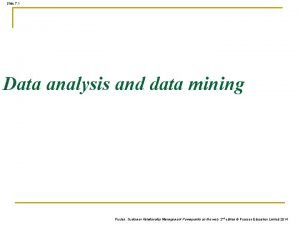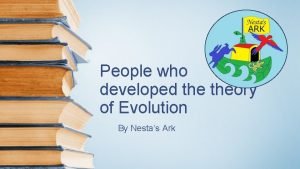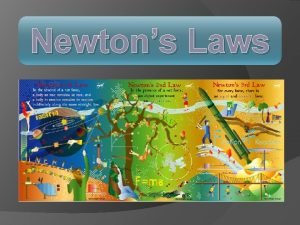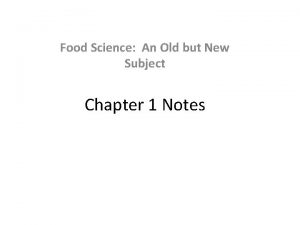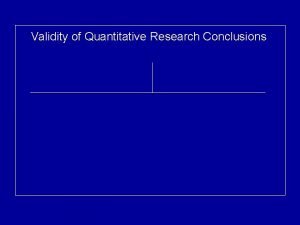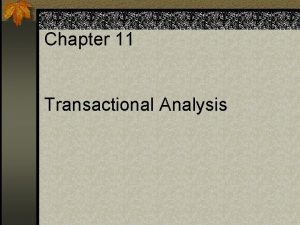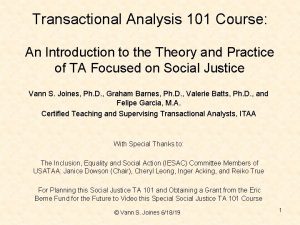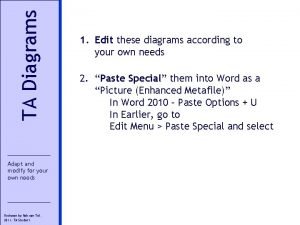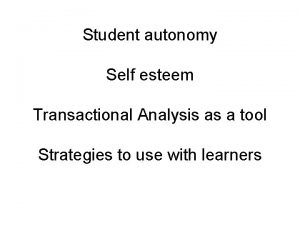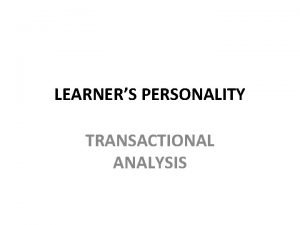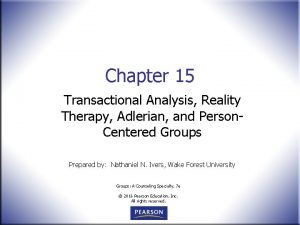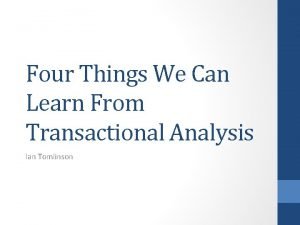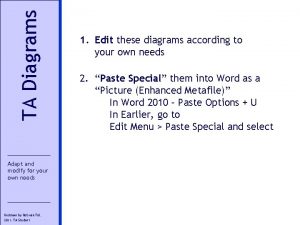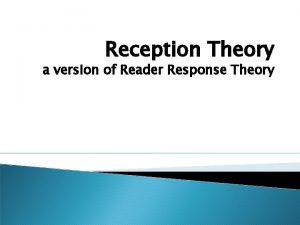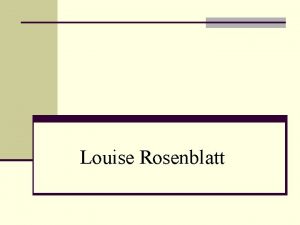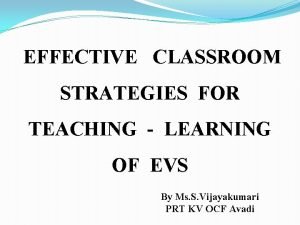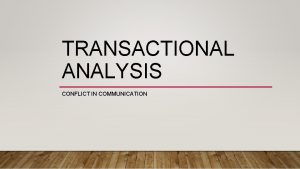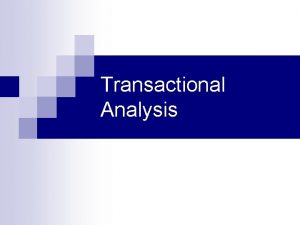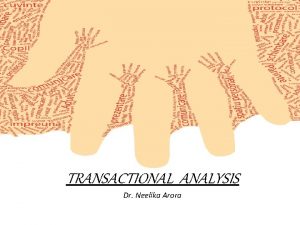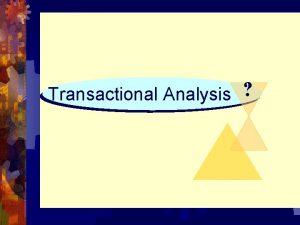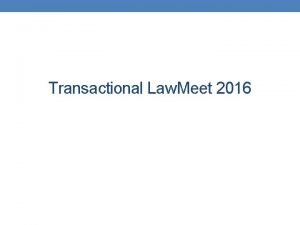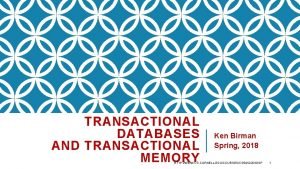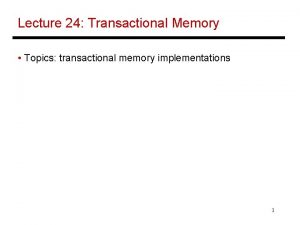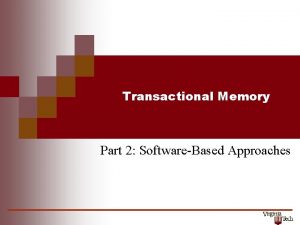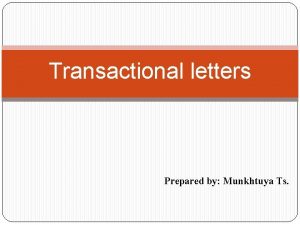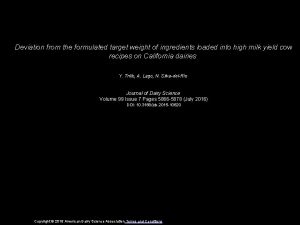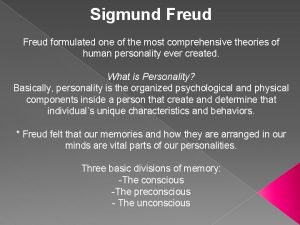Chapter 11 Transactional Analysis Transactional Analysis n Formulated






























- Slides: 30

Chapter 11 Transactional Analysis

Transactional Analysis n Formulated by Eric Berne in the early 1960’s. n Some clinicians classify as an almost purely cognitive theory with a linkage to psychoanalysis.

Eric Berne n Born in 1910 in Montreal, Canada. n During WWII, he served as an Army psychiatrist in Utah, where he started practicing group therapy. n Moved to California after the war and resumed the psychoanalytic training he had started before the war. n After being turned down for membership in the Psychoanalytic Institute he devoted his time to the development of transactional analysis.

Phases of TA Formulation (Dusay, 1977) n 1 st Phase (1955 -1962) n Berne developed the concept of ego states. n Three ego states: parent, child, adult. n 2 nd Phase (1962 -1966) n Concentrated on ideas about transactions and games. n International Transactional Analysis Association formed. n 3 rd Phase (1966 -1970) n Emphasized the reasons some individuals choose to play games in life. n 4 th Phase (1970 on) n He and his followers emphasized action and energy distribution.

View of Human Nature/Personality n An optimistic theory. n Basic assumption is that people can change despite any unfortunate events of the past. n Anti-deterministic - believing that people have choices in their lives.

Major Methods of Understanding and Predicting Human Behavior n Structural Analysis – understanding what is happening and predicting human behavior. n Transactional Analysis – describing what happens between two or more people. n Game Analysis – understanding transactions between individuals that lead to bad feelings. n Script Analysis – understanding the life plan that an individual is following.

Structural Analysis n Each person is considered to have three functional ego states: n Child, parent, and adult. n Ego state – a “consistent pattern of feeling and experience directly related to a corresponding pattern of behavior” (Berne, 1964).

Child Ego State n First to develop. n The part of the personality characterized by childlike behaviors and feelings. n Consists of two subdivisions: the natural (free) child – the part of the person that is spontaneous, impulsive, feeling-oriented, and often self-centered and pleasure-loving. n the adaptive child – the compliant part of the personality that conforms to the wishes and demands of parental figures. n

Parent Ego State n Incorporates the attitudes and behaviors (dos, shoulds, and oughts) of parental figures. n Outwardly expressed through prejudice, criticism, and nurturing behavior. n Consists of two subdivisions: the nurturing parent – the part of the person that comforts, praises, and aids others. n the critical parent – the part of the person that finds fault, displays prejudices, disapproves, and prevents others from feeling good about themselves. n

Adult Ego State n Not subdivided or related to a person’s age. n The objective, thinking, data-gathering part of the person. n The adult is rational and organized.

Focus of Transactional Analysis n A major focus of TA is determining which ego state(s) a person is using. n The different ego states may operate simultaneously. n Although TA does not favor one ego state over another, theory stresses the importance of being able to balance responses when necessary and appropriate.

Transactional Analysis n May occur on three levels: n Complementary Transaction n Crossed Transaction n Ulterior Transaction

Complementary Transaction Both persons are operating from the same ego state (child: child) or from complementary ego states (parent: child or adult: parent).

Crossed Transaction n An inappropriate ego state is activated, producing an unexpected response. n Crossed transactions hurt. n When they occur, people tend to withdraw from each other or switch topics.

Ulterior Transaction n One in which two ego states operate simultaneously and one message disguises the other. n Appear to be complementary and socially acceptable, even though they are not.

Game Analysis n Games - Ulteriorly motivated transactions that appear complementary on the surface but end in bad feelings. n People play games to: Structure time. n Achieve recognition. n Make others predictable. n Prevent intimacy. n n Because intimacy involves risks, games keep people safe from exposing thoughts and feelings.

Types of Games n First-degree games n Played in social circles with anyone willing to participate. n Generally lead to mild upsets. n Second-degree games n Occur when the players go after bigger stakes. n Usually in more intimate circles. n End up with bad feelings. n Third-degree games n Usually end up in tissue damage n The players usually end up in jail, the hospital, or the morgue.

Individuals and Game-Playing n Individuals who play games operate from one of three positions: n Victim n Persecutor n Rescuer

Script Analysis n Berne believed that everyone makes a life script (life plan) by age 5. n Determines how one interacts with others. n Based on interpretations of external events.

Permissions and Injunctions n Permissions n Positive messages given to a child. n Do not limit people in any way. n Injunctions n Negative messages. n More powerful. n May become the basis for destructive scripts.

Strokes and Stamps n Verbal or physical recognition for certain n n behaviors. Negative strokes may be better than no strokes. Strokes result in the collection of either good or bad feelings, known as stamps. When enough stamps are collected they cash them in on behaviors. Healthy people give and receive positive strokes most often.

Common Negative Script Patterns n Never scripts – a person never gets to do what he or n n she wants because the parent forbids it. Until scripts – a person must wait until a certain time to do something before he or she can have a reward. Always scripts – a person tells himself that it is necessary to continue doing the same thing. After scripts – a person expects difficulty after a certain event. Open-ended scripts – a person does not know what he is supposed to do after a given time.

Drivers n Miniscripts within people’s lives that focus on minute-by-minute occurrences. n Common miniscripts: “be perfect” “be strong” “hurry up” “try hard” “please someone”

Roles of the Counselor n Must act as a teacher and explain to the client the language and concepts of TA. n Contracts with the client for specific changes and helps the person achieve them. n Does not rely heavily on formal psychological tests, although a counselor does assess client functioning. n Assessment is done to determine how a client is spending time and from which ego states the client is operating.

Goals n Identify and restore distorted and damaged ego states. n Develop the capacity to use all ego states. n Use the adult ego state with its reasoning powers. n Alter inappropriate life scripts. n Adopt a position of “I’m OK, You’re OK. ”

TA Techniques n n n n Treatment contract Interrogation Specification Confrontation Illustration Confirmation Interpretation Crystallization Almost all techniques in TA involve some combination of questioning, confrontation, and dialogue.

Multicultural and Gender Sensitive Issues n TA has an appeal in many cultures, especially with diverse populations. n TA also seems to be an appropriate theory in working on gender sensitive issues. n TA emphasis on empowerment and contracts strengthens the position of women in TA therapy.

Strengths and Contributions n Uses terms that are easily understood and clearly n n n defined. Can be used in a number of diverse settings. Easily and effectively combined with other more action-oriented counseling. Puts the responsibility of change on the clients. Goal-directed. Has a worldwide association that sponsors certifications, conferences, and publications related to theory.

Limitations and Criticisms n Limited in its effectiveness when used alone. n Criticized for its simplicity, structure, and popularity. n Does not emphasize the authenticity of the counselor. n The research behind the approach is relatively weak. n The approach has not developed much since Berne’s death in 1970.

The Case of Linda: Transactional Analysis n How would you conceptualize this case using transactional analysis? n What would be your treatment plan for this client using transactional analysis?
 Which analysis was formulated by peelen
Which analysis was formulated by peelen Gurus of tqm
Gurus of tqm What is an exposure incident in cosmetology
What is an exposure incident in cosmetology Who formulated theory of evolution? *
Who formulated theory of evolution? * Who formulated the three laws of motion
Who formulated the three laws of motion Food science an old but new subject
Food science an old but new subject The meaning of
The meaning of No conclusion formulated in quantitative research
No conclusion formulated in quantitative research Formulated chemistries technical services
Formulated chemistries technical services Transactional analysis criticism
Transactional analysis criticism Life positions in transactional analysis
Life positions in transactional analysis Transactional analysis in organisational behaviour
Transactional analysis in organisational behaviour Counter injunctions transactional analysis
Counter injunctions transactional analysis Ta student diagrams
Ta student diagrams Life positions in transactional analysis
Life positions in transactional analysis Formula g transactional analysis
Formula g transactional analysis Types of transactions in transactional analysis
Types of transactions in transactional analysis Transactional analysis in business
Transactional analysis in business Time structuring in transactional analysis
Time structuring in transactional analysis Ta diagrams
Ta diagrams Transactional analysis drivers
Transactional analysis drivers Short transactional writing examples
Short transactional writing examples Examples of transactional text
Examples of transactional text Transactional leadership
Transactional leadership Limitations of linear model of communication
Limitations of linear model of communication Peer to peer transactional replication
Peer to peer transactional replication Peer to peer transactional replication
Peer to peer transactional replication Reader-response
Reader-response Louise rosenblatt transactional theory
Louise rosenblatt transactional theory Evs classroom
Evs classroom Community provider business model
Community provider business model
